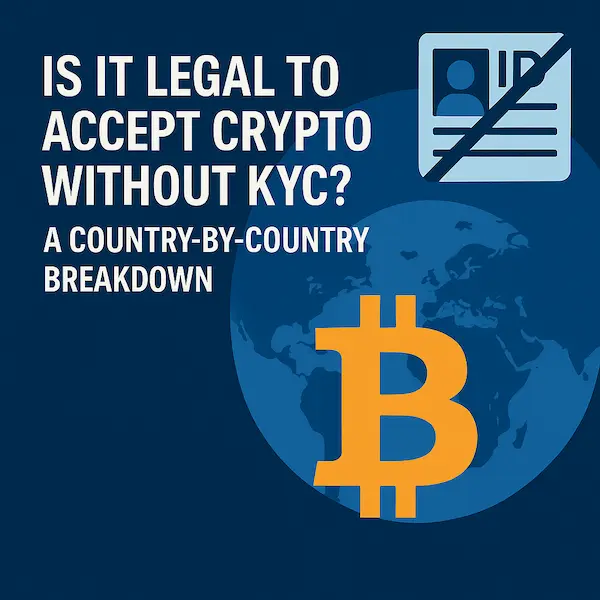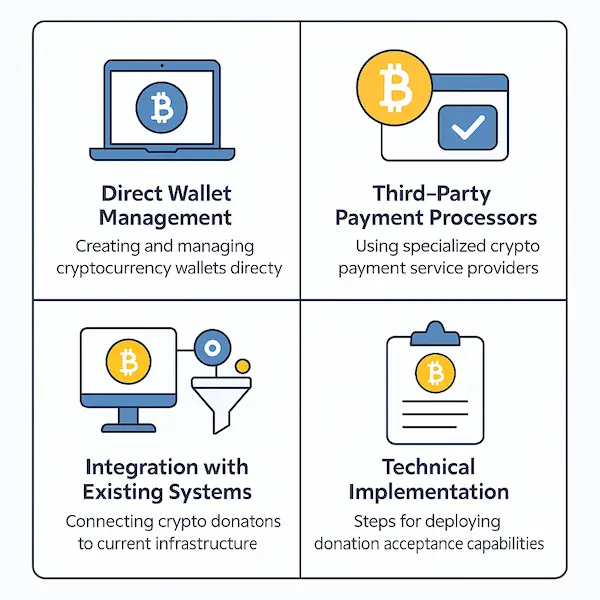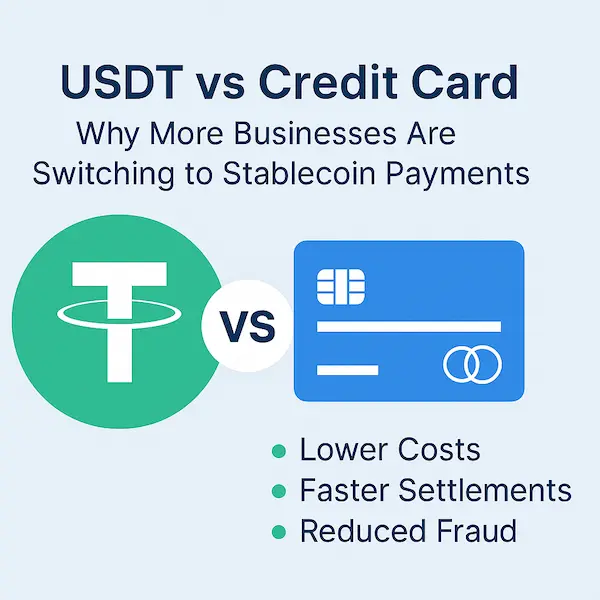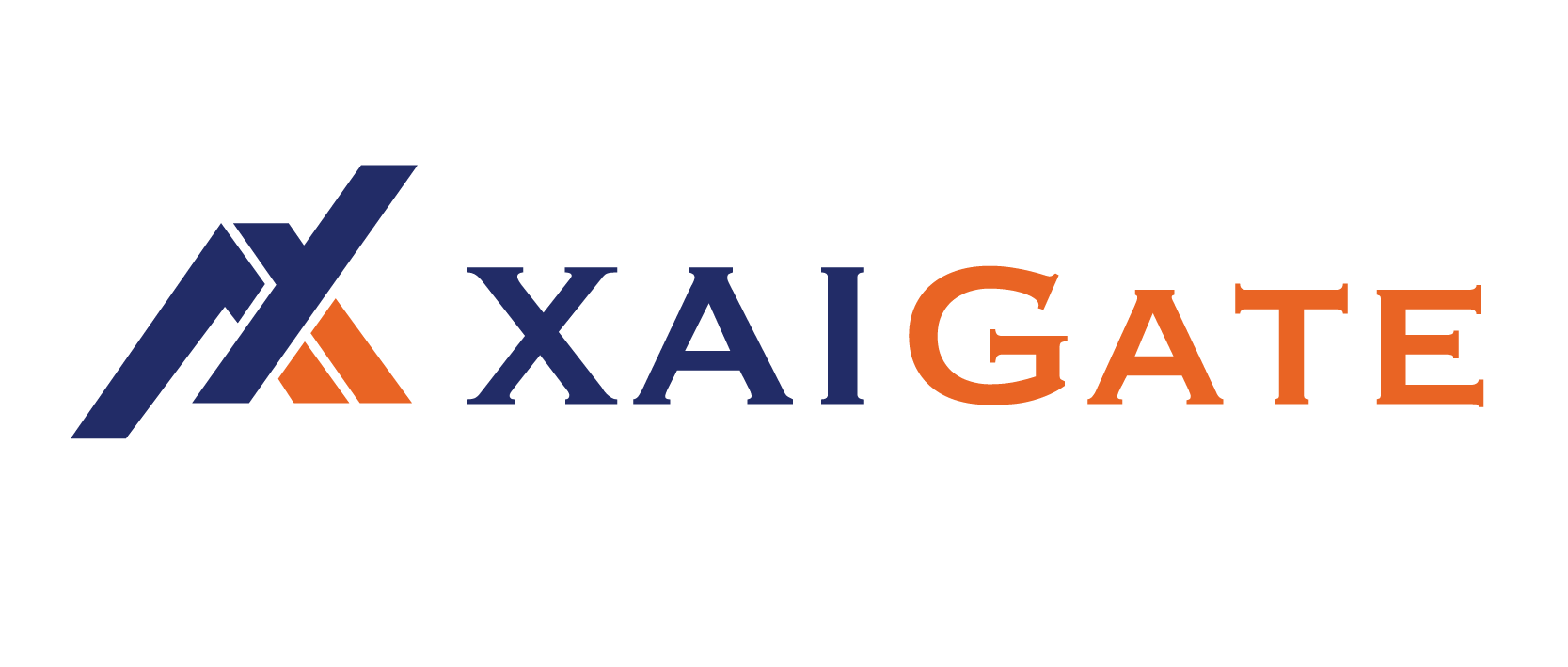In order to obtain new donors for charities, innovation is important, especially in this day and age where giving to charities is becoming digitalized. As cryptocurrency becomes more widely accepted, many organizations are looking into strategies to use these digital assets for their missions. While cryptocurrencies like Bitcoin and Ethereum can be useful, their sharp price changes can be a risk for recipients. Stablecoins, which are more stable than volatile cryptocurrencies, can serve as a balance in between the effectiveness of cryptocurrency and traditional, fiat currencies. For modern nonprofits looking to accept these 21st-century donations, understanding the stablecoin comparison for donations is imperative.
We will discuss the implications of USDT vs USDC and focus on stablecoins’ nonprofit use to comprehend the implications of DAI, USDC, and USDT for charity donations. This will, in turn, enable us to embrace the evolving nature of donating through cryptocurrencies.
Contents
- 1 Stablecoins as the Central PillAR of Modern Philanthropy.
- 2 Grasping Stablecoins: The Fundamentals
- 3 Stablecoin Comparison for Donations: USDT vs USDC vs DAI
- 4 Key Factors in Stablecoin Comparison for Donations
- 5 Optimal Approaches for Accepting Stablecoin Donations
- 6 Addressing donor and operational concerns
- 7 FAQs – Stablecoin Comparison for Donations
Stablecoins as the Central PillAR of Modern Philanthropy.
The giving landscape is changing too. A new generation of donors is emerging alongside traditional ones, which makes the idea of giving charities a lot easier. This is because the new donors are fueled by the idea of simple apps and a new generation of philanthropists are mainly digital. In order to use this new source of funding, charities need to meet this new donor halfway.
Why Assessing Volatility is Key when Comparing Stablecoins for Donations
Think about what it would be like to receive a high-value donation made in a volatile cryptocurrency. Imagine how challenging it would be if the cryptocurrency’s value decreased days before you could convert it or utilize it. The unpredictable nature of numerous cryptocurrencies poses a serious threat to nonprofit organizations that depend on consistent funding. For this reason, a thorough stablecoin comparison for donations becomes critical. Stablecoins offset this price risk, ensuring a consistent and dependable funding source, as they are intended to maintain a stable value or are pegged 1:1 to a fiat currency like the US Dollar. Stablecoins are vital in providing the nonprofit sector the much-needed stability for operational certainty and financial planning.
The Increasing Interest of Stablecoins within Nonprofits
In addition to stability, stablecoins have other attractive benefits for nonprofit organizations. The coins increase and improve transparency, speed, and lower the costs of cross-border transactions – thus easing international giving. This is especially beneficial in areas with limited access to traditional banking, as the funds will be more accessible and available to the beneficiaries in a timelier manner. In addition, the use of stablecoins aids in capturing a new market segment of a younger digitally inclined generation, broadening the organization’s reach and diversifying its revenue streams. The stablecoin comparison for donations enables organizations to utilize the benefits of donations while having strategic choice.

Grasping Stablecoins: The Fundamentals
In order to choose which stablecoin is best suited for charitable donations, it is vital to understand the basic traits of these digital currencies to make the best choice.
Stablecoin Definition
Stablecoins, as a subcategory of cryptocurrencies, are designed to mitigate price fluctuations associated with digital currencies by backing them with a stable asset such as a fiat currency or gold. In the case of stablecoins, the goal is to maintain parity at $1.00 USD The semi-peg nature of these cryptocurrencies allows them to be used in transactions, remittances, and, most importantly, charitable donations, where the speculative cryptocurrency factor is unwelcomed. Stablecoins’ attributes make them in any stablecoin comparison for donations.
Categories of stablecoins and their backing methods
Different stablecoins achieve their pegs through different backing methods:
- Fiat-backed stablecoins: These types of stablecoins are the most popular like USDT and USDC. These stablecoins are backed with the peg currency and are issued with the same amount of stablecoin. These stablecoins maintain parity as long as there is an equivalent reserve of the fiat currency, or highly liquid cash equivalents and short-term government bonds held in bank accounts. For every stablecoin token issued, there’s a corresponding dollar (or other fiat currency) held in reserve.
- Crypto-collateralized stablecoins: A classic example is DAI. These types of stablecoins are backed by other cryptocurrencies and are usually backed in an “over-collateralized” way. This means that for every $1 worth of stablecoin issued, $1.50 worth of crypto assets are locked up, creating a buffer against price fluctuations of the collateral.
- Algorithmic stablecoins: These focus on maintaining their peg using complex clever algorithms and smart contracts, without direct fiat or crypto collateral. They are generally unfit and pose a risk during critical financial operations like charitable donations, since many algorithmic stablecoins fail to maintain their peg during market stress. When choosing a stablecoin comparison for donations, the underlying collateral the stablecoin is to rely on is most important.
The significance of asset-backed stablecoins for donations
For nonprofits, both fiat-backed and well-managed crypto collateralized asset-backed stablecoins generally tend to remains the safest and most reliable in a stablecoin comparison for donations. The backing provides tangible assurance of value which minimizes the risk of de-pegging, which is vital for the value of a contribution. The inherent stability is critical to asset-backed stablecoins makes them the best stablecoin for charity.
Stablecoin Comparison for Donations: USDT vs USDC vs DAI
Let us now go straight into the comparison of the three titans of the stablecoin world and how they perform in the charity donation niche. This stablecoin comparison for donations aims to outline the pros and cons of each in a more useful and digestible manner.
| Feature | USDT (Tether) | USDC (USD Coin) | DAI (Dai) |
| Issuer/Backing | Tether Limited (Fiat-backed) | Centre Consortium (Circle & Coinbase) (Fiat-backed) | Maker Protocol (Decentralized, Crypto-collateralized) |
| Transparency | Historically faced scrutiny; regular attestations. | Highly transparent; monthly attestations by independent auditors. | Full on-chain transparency of collateral. |
| Regulatory Stance | Less regulated; operates in various jurisdictions. | Proactive regulatory compliance; U.S. regulated entities. | Decentralized, no central regulator. |
| Market Cap/Volume | Largest by market cap and trading volume. | Second largest; high market cap and strong adoption. | Significant market cap within DeFi ecosystem. |
| Liquidity | Excellent; widely available on almost all exchanges. | Excellent; widely available on major exchanges. | Good; liquid within DeFi, less so on some CEXs. |
| Decentralization | Centralized. | Centralized. | Decentralized. |
| Primary Appeal | Widespread adoption, high liquidity. | Trust, regulatory compliance, institutional backing. | Censorship resistance, decentralized ethos. |
| Ease of Conversion to Fiat | Generally easy on most exchanges (subject to exchange KYC). | Very easy on regulated exchanges (subject to exchange KYC). | Requires more familiarity with DeFi or specific exchanges. |
| Best For Nonprofits Seeking | Broad donor access, high trading volume. | Strong regulatory comfort, transparency, established trust. | Decentralized values, advanced crypto users. |
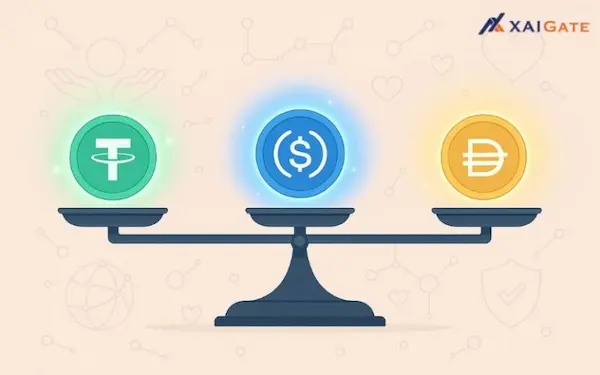
USDT (Tether): The market leader’s role in donations
Tether Limited issues USDT, which holds the title of the world’s largest stablecoin in terms of market capitalization and trading volume. It can be easily accessed on almost every cryptocurrency exchange, and it still retains its dominance in trading pair USDT. Moreover, USDT’s high liquidity makes it easy for donors to acquire and for recipients to potentially convert. Donors and recipients alike opt for USDT due to its convenience, especially with regard to nonprofit organizations.
Transparency and audits: A key consideration for USDT
In the past, Tether has come under fire for lacking audits and full transparency on their reserves. Tether does provide “attestations,” which are reports at specific intervals that verify reserves. However, these “attestations” do not cover full independent audits which are an industry standard for traditional financial institutions. Such lack of transparency can be a concern for nonprofits as transparency is key in the nonprofit sector. In the stablecoin comparison for donations trust is a key factor, and auditability heavily impacts the level of trust an organization can have concerning their donations.
USDC (USD Coin): The institutional choice for stablecoin comparison for donations
USDC, co-founded by Circle and Coinbase (now solely managed by Circle), is the second-largest stablecoin. It is widely considered to be highly transparent and regulatory compliant. USDC is 100% backed by cash and short-term U.S. Treasury bonds, held in segregated accounts with regulated U.S. financial institutions. Circle provides monthly attestations from independent auditors, offering a clearer picture of its reserves. For organizations prioritizing regulatory alignment and trust, USDC is often deemed the best stablecoin for charity donations. This often makes USDC vs USDT for donations a straightforward choice for many.
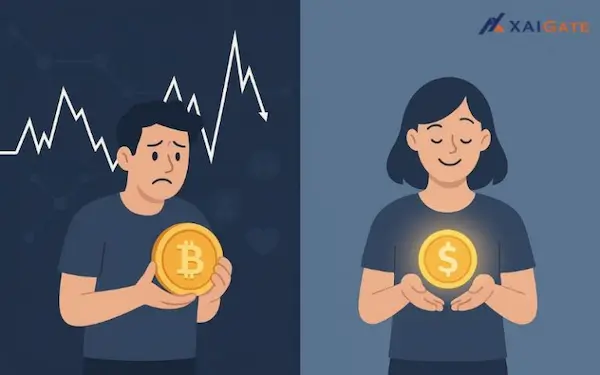
Regulatory compliance and real-world utility of USDC
Regulatory compliance is a key feature for institutional investors and organizations in established financial industries. USDC’s strong backing and its audits add to the stablecoin’s reputation. It is enhancing its use cases beyond cryptocurrency trading, including cross-border payments and remittances, which makes it easier for nonprofit organizations to use. The stringent regulatory compliance is a strong advantage in any stablecoin comparison for donations.
DAI (Dai): Decentralized stability for your cause
DAI is the stablecoin developed by a DAO called the Maker Protocol. Different from USDT and USDC, which have a central distributor, DAI is a stablecoin that is crypto-collateralized and decentralized. Different cryptocurrencies are used to back collateralized debt positions (CDPs) which are managed by smart contracts to keep the stablecoin pegged to the US Dollar. For organizations valuing censorship resistance and autonomy, DAI’s decentralized nature is a great choice.
How DAI’s over-collateralization impacts donations
DAI’s over-collateralized nature means more than $1 worth of crypto assets is locked for $1 DAI. To generate 100 DAI, one needs to deposit $150 worth of Ethereum. This over-collateralization helps DAI in maintaining its peg by countering volatility. Though this offers a safe decentralized guarantee, the whole process of redeeming DAI is more complex than the average finance person would expect from traditional finance. For donations, the over-collateralization model presents an interesting point in the stablecoin comparison for donations.
Key Factors in Stablecoin Comparison for Donations
Several capturing USDT, USDC, and DAI’s individual features should emphasize focus on stablecoin comparison for donations.
Liquidity and accessibility for donors
A stablecoin’s liquidity indicates the degree to which it can be exchanged for other assets, like fiat currency, without incurring a significant cost. USDT, without a doubt, has the highest liquidity and is listed on the most exchanges internationally, thereby being the most accessible to donors. USDC also enjoys superb liquidity and is widely available, especially in regulated markets. DAI has less liquidity on centralized exchanges compared to USDT and USDC. While DAI is liquid within the DeFi system, it is less accessible for everyday users than USDT and USDC. Therefore, the more difficult it is for a donor to acquire stablecoin, the less successful your effort to collect stablecoins for non-profit organizations will be granted.
Transaction fees and network compatibility
The cost of sending stablecoins is controlled by the blockchain network which they operate on. For sending stablecoins, the Ethereum network can be more expensive due to gas fees, especially in congested periods. Nevertheless, all three stablecoins can be found on other networks like Tron (for USDT), Polygon, Solana, or BNB Smart Chain which do not charge as high fees. When evaluating stablecoin comparison for donations, consider which payment networks are most preferred by your donors and which charge the lowest fees. This way, more of the donation will be received by the cause.

Read mores: Top 3 Tools to Generate a Bitcoin Donation Button Instantly (Free & Paid)
Regulatory landscape and compliance for stablecoins for nonprofit organizations
Cryptocurrencies, and stablecoins, in particular, are undergoing regulatory change in almost every country, and quite rapidly, too. USDC’s regulatory compliance efforts have made it a go-to stablecoin for compliance-conscious institutions and organizations. USDT’s preference for more offshore jurisdictions has caused it some regulatory trouble. DAI has a different set of regulatory issues due to its decentralized nature and lack of a central issuer. Nonprofits need to be aware of the regulations in their own jurisdictions and need to select a stablecoin that matches their compliance risk appetite. This regulatory landscape heavily impacts the best option in a stablecoin comparison for donations.
Tax implications of stablecoin donations
Donating cryptocurrency, including stablecoins, to a qualified nonprofit in some jurisdictions comes with tax benefits for the donor, especially after a year of holding the asset. Upon receiving the stablecoin, for the nonprofit, it is typically not a taxable event. The act of converting the stablecoin to fiat currency, however, can be a taxable event if there’s any gain (or loss) from the time of receipt to the conversion. Organizations, especially accepting crypto for donations, need to understand their nonprofit designation and tax regulations should seek advice from crypto tax experts.
Optimal Approaches for Accepting Stablecoin Donations
After analyzing stablecoin comparison for donations, following best practices will guarantee streamlined donations and a successful fundraising campaign.
Selecting the Appropriate Stablecoin for Charitable Donations
Considering the above-stated parameters, here is a typical framework to assist in making your selection:
- If you are open to a little less transparency and a bit of a trade-off in trust, for the highest liquidity and global utility: USDT might be considered.
- The USDC stablecoin stands above the rest for charitable donations because of it’s regulatory compliance, transparency, and institutional trust. USDC is mostly favored by those with little overhead for regulatory compliance and institutional trust.
- From the standpoint of technological familiarity and censorship resistance: DAI is also an option.
Numerous organizations prefer to receive multiple stablecoins as it meets the needs of a wider donor audience. Hence, their effort for stablecoin comparison for donations never ends.
Merging stablecoin donations into your fundraising framework
Don’t expect anything to come from simply adding a stablecoin address and strategically incorporating it:
- Receives for donations with stablecoin: On your website create a page for stablecoin donations and state the stablecoins you accept with their corresponding wallet addresses. Ensure the page is not cluttered and is easy to navigate.
- Educational Content: Create step-by-step guides and address common questions for donors on how to donate using stablecoins.
- Marketing: Promote your acceptance of stablecoins through newsletters, social media, and other communications. Inform your community that the stablecoin comparison for donations has been conducted and you are ready!
Using a platform like Xaigate facilitates crypto donations for nonprofits
Although donations can be made from wallet to wallet directly, using a platform that specializes in crypto donations for nonprofits greatly simplifies the process. Platforms like Xaigate are made to process donations in a wide range of cryptocurrencies, including stablecoins. They often manage the complicated tasks of creating numerous addresses, tracking donations, automated tax receipt issuance, and crypto to fiat conversions. This shifts some of the workload off your team and onto the platform, reducing operational burden, allowing you to focus on your mission. Platforms like Xaigate can seamlessly integrate your chosen stablecoins, making the stablecoin comparison for donations much easier to implement.
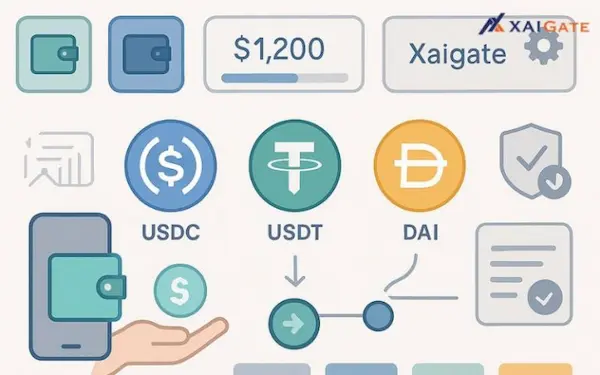
Read more: Accept cryptocurrency donations for Nonprofit Organizations
Addressing donor and operational concerns
To accomplish successful stablecoin fundraising, tactical concerns for your donors and internal operations must be addressed.
Educating your donor base on stablecoin comparison for donations
Many potential donors may lack knowledge regarding how stablecoins work. Providing them with clear educational materials explaining stable coins will go a long way. Describe the stability and efficiency scopes of stablecoins as well as their step by step guide of donating. This education will build confidence and easg contributions. Focus on their stablecoin comparison for donations making sure ease of use is emphasized.
Converting stablecoins to fiat: strategies for nonprofits
Beyond earning stablecoins as donations, many nonprofits will need to convert stablecoins to fiat currency to accomplish their goals and fund operations.
- Instant Conversion: Xaigate is an example of a crypto donation platform that offers automatic conversion services without requiring request approval. This eliminates conversion volatility risk.
- Manual Conversion: This approach offers the most control to the user as they can decide the timing of the transaction, but adds volatility risk. Your organization can send the stablecoins from a noncustodial wallet to a centralized crypto exchange which will require KYC for your organization. This adds risk because the coins must be held for some time during the exchange.
- Holding Stablecoins: DeFi yielding might incentivize some firms to hold stablecoins, but this adds a layer of complexity and risk. Most nonprofits will want to convert immediately. The approach you select will affect the stablecoin comparison for donations.
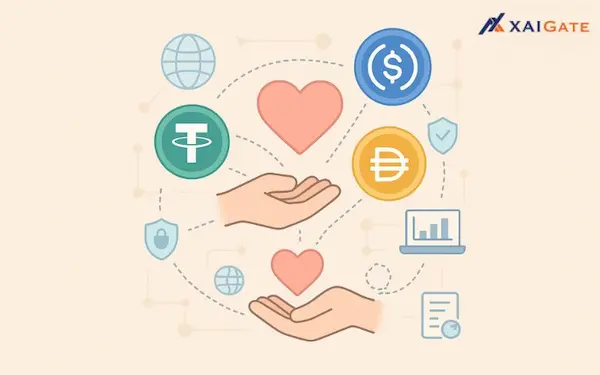
The stablecoin comparison for donations will assist nonprofits in identifying the most impactful stablecoin for donations. Furthermore, embracing stablecoins with the intent for charitable giving will greatly enhance operational efficiency and attract a greater donor base. Stablecoins ranked with liquidity, compliance, transparency, and other relevant attributes will greatly benefit the organization offering charity donations.
USDT adoption, USDC compliance, and DAI’s decentralization are some of the features stablecoins for donation offer. The empowericht to stablecoins enables non-profit organizations to operate confidently and strategically, navigating the emerging philanthropic landscape.
FAQs – Stablecoin Comparison for Donations
1. Which stablecoin is best for nonprofit donations—USDT, USDC or DAI?
USDT and USDC are most widely used thanks to their liquidity and stability. DAI is fully decentralized and suitable for donors prioritizing governance control.
2. Are stablecoin donations faster and cheaper than traditional payment methods?
Yes, stablecoin transfers generally settle in minutes and incur far lower fees than credit cards or bank wires, making them ideal for global nonprofit use.
3. Can donors use any wallet or platform to send stablecoin donations?
Donors can send from most compatible wallets, but nonprofits should ensure their platform, like XAIGATE, supports popular stablecoins and chains.
4. Is regulatory compliance a concern when accepting stablecoin donations?
Compliance varies by region. Platforms like XAIGATE include KYC/AML checks and reporting tools to help nonprofits stay within legal norms.
5. How should NGOs choose between USDT, USDC, and DAI for donations?
It depends on priorities: USDC for transparency and regulation, USDT for reach and liquidity, and DAI for decentralized governance supporters.
6. Can stablecoin donations be converted to local currency automatically?
Yes, some donation platforms auto-convert to fiat or other crypto, helping nonprofits avoid volatility while simplifying accounting.
7. What info should donors and nonprofits record for stablecoin transactions?
Keep transaction IDs, wallet addresses, timestamps, donor contact details (if any), and platform-generated receipts to ensure auditability.
8. Do stablecoin donations provide more transparency than cash gifts?
Absolutely. Every stablecoin transfer is recorded on-chain, enabling nonprofits to offer verifiable, timestamped donation logs to supporters.
9. Are there risks in accepting stablecoin donations during high-volatility periods?
Stablecoins by design aim for $1 peg, but some (especially algorithmic ones) may depeg. Using well‑established coins like USDC or USDT minimizes such risk.
10. How do nonprofits compare platforms that accept stablecoin donations?
Look at supported coins, fees, integration options, compliance features, and whether the platform offers reporting dashboards and tax receipts.
For daily updates, subscribe to XAIGATE’s blog!
We may also be found on GitHub, and X (@mxaigate)! Follow us!


